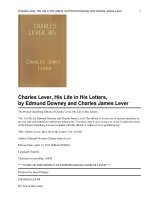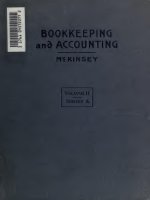XML demystified by james keogh and ken davidson (242 pages, 2005)
Bạn đang xem bản rút gọn của tài liệu. Xem và tải ngay bản đầy đủ của tài liệu tại đây (1.5 MB, 242 trang )
XML DEMYSTIFIED
This page intentionally left blank
XML DEMYSTIFIED
JIM KEOGH & KEN DAVIDSON
McGraw-Hill
New York Chicago San Francisco Lisbon London
Madrid Mexico City Milan New Delhi San Juan
Seoul Singapore Sydney Toronto
Copyright © 2005 by The McGraw-Hill Companies. All rights reserved. Manufactured in the United States of America. Except
as permitted under the United States Copyright Act of 1976, no part of this publication may be reproduced or distributed in any form
or by any means, or stored in a database or retrieval system, without the prior written permission of the publisher.
0-07-148789-1
The material in this eBook also appears in the print version of this title: 0-07-226210-9.
All trademarks are trademarks of their respective owners. Rather than put a trademark symbol after every occurrence of a trademarked
name, we use names in an editorial fashion only, and to the benefit of the trademark owner, with no intention of infringement of the
trademark. Where such designations appear in this book, they have been printed with initial caps.
McGraw-Hill eBooks are available at special quantity discounts to use as premiums and sales promotions, or for use in corporate
training programs. For more information, please contact George Hoare, Special Sales, at or (212)
904-4069.
TERMS OF USE
This is a copyrighted work and The McGraw-Hill Companies, Inc. (“McGraw-Hill”) and its licensors reserve all rights in and to the
work. Use of this work is subject to these terms. Except as permitted under the Copyright Act of 1976 and the right to store and
retrieve one copy of the work, you may not decompile, disassemble, reverse engineer, reproduce, modify, create derivative works
based upon, transmit, distribute, disseminate, sell, publish or sublicense the work or any part of it without McGraw-Hill’s prior
consent. You may use the work for your own noncommercial and personal use; any other use of the work is strictly prohibited. Your
right to use the work may be terminated if you fail to comply with these terms.
THE WORK IS PROVIDED “AS IS.” McGRAW-HILL AND ITS LICENSORS MAKE NO GUARANTEES OR
WARRANTIES AS TO THE ACCURACY, ADEQUACY OR COMPLETENESS OF OR RESULTS TO BE OBTAINED FROM
USING THE WORK, INCLUDING ANY INFORMATION THAT CAN BE ACCESSED THROUGH THE WORK VIA
HYPERLINK OR OTHERWISE, AND EXPRESSLY DISCLAIM ANY WARRANTY, EXPRESS OR IMPLIED,
INCLUDING BUT NOT LIMITED TO IMPLIED WARRANTIES OF MERCHANTABILITY OR FITNESS FOR A
PARTICULAR PURPOSE. McGraw-Hill and its licensors do not warrant or guarantee that the functions contained in the work will
meet your requirements or that its operation will be uninterrupted or error free. Neither McGraw-Hill nor its
licensors shall be liable to you or anyone else for any inaccuracy, error or omission, regardless of cause, in the work or for any
damages resulting therefrom. McGraw-Hill has no responsibility for the content of any information accessed through the work. Under
no circumstances shall McGraw-Hill and/or its licensors be liable for any indirect, incidental, special, punitive, consequential or
similar damages that result from the use of or inability to use the work, even if any of them has been advised of the possibility of
such damages. This limitation of liability shall apply to any claim or cause whatsoever whether such claim or cause arises in contract,
tort or otherwise.
DOI: 10.1036/0072262109
Professional
Want to learn more?
We hope you enjoy this
McGraw-Hill eBook! If
you’d like more information about this book,
its author, or related books and websites,
please click here.
This book is dedicated to Anne, Sandy, Joanne,
Amber-Leigh Christine, and Graff, without whose help
and support this book couldn’t have been written.
—Jim
To Liz, Alex, Jack and Janice.
—Ken
ABOUT THE AUTHORS
Jim Keogh is on the faculty of Columbia University and Saint Peter’s College in
Jersey City, New Jersey. He developed the e-commerce track at Columbia University.
Keogh has spent decades developing applications for major Wall Street corporations
and is the author of more than 60 books, including J2EE: The Complete Reference,
Java Demystified, ASP.NET Demystified, Data Structures Demystified, and others
in the Demystified series.
Ken Davidson is a Columbia University faculty member in the computer science
department. In addition to teaching, Davidson develops applications for major
corporations in both Java and C++.
Copyright © 2005 by The McGraw-Hill Companies. Click here for terms of use.
CONTENTS AT A GLANCE
CHAPTER 1
XML: An Inside Look
1
CHAPTER 2
Creating an XML Document
17
CHAPTER 3
Document Type Definitions
33
CHAPTER 4
XML Schema
51
CHAPTER 5
XLink, XPath, XPointer
69
CHAPTER 6
XSLT
83
CHAPTER 7
XML Parsers and Transformations
95
CHAPTER 8
Really Simple Syndication (RSS)
109
CHAPTER 9
XQuery
121
CHAPTER 10
MSXML
149
Final Exam
189
Answers to Quizzes and Final Exam
205
Index
215
vii
This page intentionally left blank
For more information about this title, click here
CONTENTS
Introduction
xv
CHAPTER 1
XML: An Inside Look
XML: In the Beginning
What Is XML?
Why Is XML Such a Big Deal?
Document Type Definitions
Where to Place the DTD
Reading an XML Document
Why Are Corporations Switching to XML?
Web Services
Looking Ahead
Quiz
1
2
3
6
6
8
10
12
13
13
14
CHAPTER 2
Creating an XML Document
Identifying Information
Creating XML Markup Tags
Parent ... Parent/Child ... Child
Creating a Document Type Definition
Creating an XML Document
Attributes
Comments
Entities
Processing Instructions
CDATA Sections
Looking Ahead
Quiz
17
18
19
20
22
23
25
27
28
29
29
30
31
ix
XML Demystified
x
CHAPTER 3
CHAPTER 4
CHAPTER 5
Document Type Definitions
Types of Document Type Definition
External Document Type Definition
Shared Document Type Definition
Element Declarations
Specifying the Number of Occurrences
in an Element
Optional Child Elements
Grouping Elements
EMPTY and ANY Elements
Naming Elements
Attribute Declarations
Entity Declarations
Looking Ahead
Quiz
33
34
35
38
40
XML Schema
Inside an XML Schema
Document Type Definition
vs. XML Schema
An Inside Look at an XML Schema
Defining Simple Elements
Defining Attributes
Facets
Working with Whitespace Characters
Complex Elements
Setting the Number of Occurrences
Looking Ahead
Quiz
51
52
XLink, XPath, XPointer
An Inside Look at XLink
Speaking the XLink Language
69
70
71
41
42
43
45
45
46
47
47
48
53
55
56
57
58
62
63
65
66
67
CONTENTS
xi
XPath
A Closer Look at XPath
Predicates
Functions
XPointer
Looking Ahead
Quiz
73
75
76
77
80
80
81
CHAPTER 6
XSLT
What Is XSLT?
XPath and the Transformation
Source and Result Documents
XSLT in Action
A Closer Look at XSL Stylesheet
Looking Ahead
Quiz
83
84
84
85
85
87
92
93
CHAPTER 7
XML Parsers and Transformations
Parsing an XML Document
The Simple API for XML (SAX)
Components of a SAX Parser
The DTD Handler
The Document Object Model
Java and Parsing an XML Document
Looking Ahead
Quiz
95
96
96
97
99
100
104
105
106
CHAPTER 8
Really Simple Syndication (RSS)
What Is Really Simple Syndication (RSS)?
Inside an RSS Document
More About the channel Element
Communicating with the Aggregator
More About the item Element
109
110
110
112
114
116
XML Demystified
xii
CHAPTER 9
CHAPTER 10
Looking Ahead
Quiz
118
118
XQuery
Getting Started
Testing Saxon-B
How XQuery Works
For, Let, and Order By Clauses
The Where and Return Clauses
A Walkthrough of an XQuery
Constructors
Conditional Statements
Retrieving the Value of an Attribute
Retrieving the Value of an Attribute
and the Attribute Name
Functions
Looking Ahead
Quiz
121
122
122
126
126
126
127
128
131
136
MSXML
What Is MSXML?
Getting Down and Dirty with MSXML
Loading a Document
The LoadDocument() Function
Adding a New Element
The LoadNewNode() Function
The InsertFirst() Method
The InsertLast() Method
The InsertBefore() Function
The InsertAfter() Function
Create a New Element Programmatically
Select, Extract, Delete, and Validate
The SelectArtist() Function—Filtering
an XML Document
149
149
150
158
159
161
162
163
166
168
171
173
177
138
141
145
146
177
CONTENTS
xiii
The DisplayTitles() Function
The DeleteNodes() Function
The ValidateDocument() Function
MSXML and XSLT
CD Listing
Summary
Quiz
179
180
181
184
186
186
187
Final Exam
189
Answers to Quizzes and Final Exam
205
Index
215
This page intentionally left blank
INTRODUCTION
If you marveled at how you can use HTML to tell a browser how to display
information on your web page, then you’re going to be blown off your seat when
you master XML. XML is a standard for creating your own markup language—you
might say your own HTML. You define your own tags used to describe a
document.
Why would want to create your own markup language?
Suppose you were in the insurance industry and wanted to exchange documents
electronically with business partners. A markup language can be used to describe
each part of the document so everyone can easily identify elements of the document
electronically.
Suppose you were in the publishing industry and wanted online retailers to
display information about all your books in their electronic catalog. The table of
contents, author name, chapters, and other components of a book can be electronically
picked apart and sent to online retailers using customized XML tags.
HTML is a standard set of tags that is universally used throughout the world. A
similar set of tags can be established by an industry to describe industry-specific
documents using XML. For example, the pharmaceutical industry can create a
standard tag set to describe drugs such as dose, scientific name, and brand name.
Once an XML tag set is defined, you can use those tags just like you use HTML
tags to create a web document. And like HTML, XML tags can be interpreted into
HTML tags so your document can be displayed in a browser.
Furthermore, you can electronically:
• Parse XML documents
• Search XML document
• Create new XML documents
xv
Copyright © 2005 by The McGraw-Hill Companies. Click here for terms of use.
XML Demystified
xvi
• Insert data into an XML document
• Remove data from an XML document
• And much more.
XML confuses many who are familiar with managing data using a database. Both
a database and XML are used to manage data. However, XML is used to manage data
that doesn’t lend itself to a traditional database such as a legal document, a book, or
an insurance policy. It just isn’t easy to cram those into a formal database.
However, XML is perfect for managing that type of information because you can
create your own tags that describe parts of those documents. Best of all, there are
tools available that enable you to search and manipulate parts of an XML document
similar to how you use a database.
XML Demystified shows you how to define your own set of markup tags using
XML and how to use electronic tools to make an XML document a working part of
your business.
By the end of this book you’ll be able to make your own classy markup tags that
will leave even the sophisticated business manager in awe—and the IT department
left scratching their heads, asking: How did he do that?
A Look Inside
XML can be challenging to learn unless you follow the step-by-step approach that
is used in XML Demystified. Topics are presented in an order in which many
developers like to learn them—starting with basic components and then gradually
moving on to those features found on classy websites.
Each chapter follows a time-tested formula that first explains the topic in an
easy-to-read style and then shows how it is used in a working web page that you can
copy and load yourself. You can then compare your web page with the image of the
web page in the chapter to be assured that you’ve coded the web page correctly.
There is little room for you to go adrift.
Chapter 1: XML: An Inside Look
No doubt you heard a lot about XML since many in the business community see
XML as a revolutionary way to store, retrieve, and exchange information within a
firm and among business partners. The first chapter provides you with an overview
of XML before learning the nuts and bolts of applying XML to solve a real business
problem.
INTRODUCTION
Chapter 2: Creating an XML Document
Now that you have an understanding of what XML is and how it works, it is time to
learn how to apply your knowledge and design your own set of XML markup tags.
Chapter 2 shows you step by step how to create a set of XML markup tags by
finding natural relationships among pieces of information in your document.
Chapter 3: Document Type Definitions
Markup tags used in an XML document conform to a standard set of markup tags
that are adopted by a company or an industry. An XML standard is defined in a
document type definition that specifies markup tags that can be used in the XML
document and specifies the parent-child structure of those tags. Chapter 3 takes an
in-depth look at how to develop your own document type definition.
Chapter 4: XML Schema
A parser is software used to extract data from an XML document. However, before
doing so, the parser must learn about the XML tags used to describe data in the
document by using an XML schema. In this chapter you’ll learn how to create an
XML schema for your XML document.
Chapter 5: XLink, XPath, XPointer
Real-world XML documents can become complex and difficult to navigate, especially
if the document references multiple external resources such as other documents and
images. Professional XML developers use XML’s version of global position satellites
to find elements within the XML document by using XLink, XPath, and XPointer.
Sound confusing? Well, it won’t be by the time you finish this chapter.
Chapter 6: XSLT
A common problem facing anyone who works with data is that data is usually
stored in different formats. For example, some systems store a date as 1/1/09 while
others store it as 01 Jan 09. However, much of this problem can be resolved by
using XML because data in an XML document can be easily converted into any
format by using a stylesheet. A stylesheet is a road map that shows how to convert
the XML document into another format. In this chapter, you’ll learn how to create
a stylesheet and how to use an XSLT processor to transform an XML document into
an entirely different format.
xvii
XML Demystified
xviii
Chapter 7: XML Parsers and Transformations
The powerhouse that makes an XML document come alive is the parser. A parser
can transform a bunch of characters in an XML document into anything you can
imagine. There are many parsers that you can choose from. This chapter provides
you with insight into each standard, enabling you to make an intelligence choice
when selecting a parser to transform your XML documents.
Chapter 8: Really Simple Syndication (RSS)
If you ever wished there was a way to distribute your web content to the millions of
web sites on the Internet, then you’ll enjoy reading this chapter. RSS is an application
of XML that is used to register your content with companies called aggregators.
Aggregators are like a chain of supermarkets for web site content. In this chapter,
you’ll how to create an RSS document that contains all the information an aggregator
requires to offer your content to other web site operators.
Chapter 9: XQuery
Think of XQuery as your electronic assistant who knows where to find any
information in an XML document as fast as your computer will allow. Your job is
to use the proper expression to request the information. In this chapter, you’ll
harness the power of XQuery by learning how to write expressions that enables you
to tap into the vast treasure trove of information stored in an XML document.
Chapter 10: MSXML
MSXML is an application program interface (API) that enables you to unleash an
XML document from within a program written with such programming languages
as JavaScript, Visual Basic, and C++ by using Microsoft’s XML Core Services,
simply referred to as MSXML. Any XML document can easily be integrated into
your application by calling features of MSXML from within your program. You’ll
learn about MSXML in this chapter and how to access an XML document using
JavaScript. The same basic principle used for JavaScript can be applied to other
programming languages.
CHAPTER
1
XML:
An Inside Look
No doubt you’ve heard a lot about Extensible Markup Language (XML) since many
in the business community see it as a revolutionary way to store, retrieve, and
exchange information within a firm and among business partners.
Also you’ve probably assumed that XML has something to do with HyperText
Markup Language (HTML) since the two languages have similar names—and you
are correct. Both HTML and XML are markup languages that describe something.
It’s that something where HTML and XML go their separate ways.
HTML describes how data should look on the screen. XML describes the data itself.
It sounds a bit confusing at first, but consider the title of a book. HTML might say the
title should be displayed in bold italics. XML might say that this is a book title.
XML is a flexible markup language that you create yourself. That is, you decide
the XML tags that describe data rather than having to adhere to a standard set of
tags as you do with HTML. This flexibility enables firms and industries to create
their own standard tags to describe data that’s particular to their business.
1
Copyright © 2005 by The McGraw-Hill Companies. Click here for terms of use.
XML Demystified
2
However, we’re getting ahead of ourselves. Let’s take a step back, and we’ll give
you an overview of XML before showing you the nuts and bolts of applying XML
to solve a real business problem.
XML: In the Beginning
Think for a moment: How would you share legal documents among various
computer systems so users can retrieve and reformat the documents easily? This
can be tricky to accomplish because legal documents aren’t like a stack of order
forms, where each form has the same kind of information (i.e., customer number,
product number) that can be stored in a database. Legal documents have similarities
but the text in these documents differs.
This was the problem IBM faced in 1969 when one of their research teams set
out to develop a way to integrate information used in law offices. Charles Goldfarb,
Ed Losher, and Ray Lorie were members of the team that came up with a solution—
Generalized Markup Language (GML). GML consisted of words that described
pieces of a legal document.
Although the text in one legal document differs from that in another legal
document, legal documents are organized into specific sections. GML was used to
identify each section, making it relatively easy for an information system to store
and retrieve a section of a legal document.
In 1974, Goldfarb transformed GML into a new all-purpose markup language
called Standard Generalized Markup Language (SGML), which the International
Organization for Standardization (ISO) eventually adopted in 1986 as a recognized
standard used in electronic publishing.
SGML had one major drawback: It was considered too complex. Tim BernersLee and Anders Berglund set out to simplify SGML so that it could readily be used
to share technical documents over the Internet. Their solution: HTML. HTML
consists of a limit set of standard tags that describes how information is to be
displayed.
It is this capability that gives HTML its strength—and its weakness. Applications
that can read HTML tags can display an HTML document without having to know
anything about the document. This differs from a database application that needs to
know everything about each data element in the document, such as data type and
size, in order to display the data.
However, HTML doesn’t describe the data and there’s no way for you to enhance
the HTML set to describe data. This is the primary weakness of HTML. For
example, you can use HTML tags to specify how a book title is displayed, but you
cannot use them to identify text as a book title.
CHAPTER 1
XML: An Inside Look
3
It wasn’t until 1998, when the World Wide Web Consortium (W3C) agreed to a
new standard—XML, that this problem was solved. XML, a subset of SGML, is
used to develop a customizable markup language that is as simple to use as HTML
and that works with HTML.
As you’ll see throughout this book, you’ll be able to define your own set of XML
tags that describes information that’s relative to your business. Furthermore, you’ll
be able to use HTML to tell the browser—and other applications that can read
HTML—how to display that information.
What Is XML?
In a nutshell, XML is a markup language that’s used to represent data so data can be
easily shared among different kinds of applications that run on different operating
systems. To appreciate this, let’s take a look at how data is exchanged without XML.
Let’s say that you have a hot new web site that sells books. Your site displays the
book’s ISBN, or International Standard Book Number (the unique number that
identifies a book from other books), title, author, table of contents, and other kinds
of information that you normally find on a bookseller’s web site. All this information
is stored in a database and is inserted into a dynamic web page whenever a visitor
inquires about the book.
Book information is stored in one or more database tables. A table is similar to a
spreadsheet in that it has columns and rows (see Table 1-1). Columns represent a
particular kind of data. That is, all book titles appear in the same column and all
author names appear in a different column. Each kind of data has its own column.
Rows represent books. That is, each row has one ISBN, book title, the author(s),
one table of contents, and so on.
ISBN
Title
Author
Table of Contents
0072254548
Java Demystified
Jim Keogh
Chapter 1
Chapter 2
Chapter 3
Chapter 4
Chapter 5
0072253592
Data Structures Demystified
Jim Keogh and
Ken Davidson
Chapter 1
Chapter 2
Chapter 3
Chapter 4
Chapter 5
Table 1-1
A Table of Data About a Book That Is Stored in a Database
XML Demystified
4
Columns are described in a variety of ways, depending on the nature of the
application and the design of the database. For example, typically, the minimum
description for a column in a table that contains information about books includes
• Column name
• Column type (text, numeric, Boolean)
• Maximum size (maximum number of characters that can be stored in
the column)
However, some database designers might also describe columns as having a
• Minimum size (minimum number of characters that can be stored in the
column)
• Label (text that appears alongside the data when the data is displayed
or printed)
• Validation rules (criteria the data must meet before being inserted into
the column)
• Formatting (such as the use of hyphens in a Social Security Number)
The list of ways to describe a column seems endless. In order for the data from
one application to be shared with another application, this application must be able
to understand how each column is described. For example, it must know that the
ISBN is text and not a numeric value although an ISBN contains numbers. Otherwise,
it might not interpret the data properly.
Furthermore, the application receiving data must know that the ISBN number
comes before the title, and the title comes before the author, and the author comes
before the table of contents, and so on. Otherwise the application might treat the
ISBN number as the author.
Before any data can be exchanged, the developer of the application receiving
data must obtain this description of the data and modify the app to read the data.
This is time-consuming and complex.
XML makes sharing data at lot easier by enabling a company or, in many cases,
an industry to define a standard set of markup tags that describe data. These markup
tags are then combined with data to form an XML document, which is then made
available to other applications.
These applications reference a known set of tags in order to extract data from the
XML document. There is no need to exchange data descriptions because the set of
markup tags already describes data in the XML document.
Let’s return to our online bookstore example to see how this works. Suppose the
book industry agrees on a standard set of markup tags to describe a book. The book
CHAPTER 1
XML: An Inside Look
publisher creates an XML document that uses these markup tags to describe each
of the publisher’s books. The XML document is then distributed to retailers and
others who require information about a publisher’s line of books.
Here is a very simple version of such an XML document. You probably have no
trouble understanding this document because the XML tags clearly describe the
data. The XML tags are similar in appearance to HTML tags in that there is an open
tag (<books>) and a closed tag (</books>). However, unlike HTML, we made up
the tag name.
<books>
<book>
<isbn>0072254548</isbn>
<title>Java Demystified</title>
<author>Jim Keogh</author>
<toc>
Chapter 1
Chapter 2
Chapter 3
Chapter 4
Chapter 5
</toc>
</book>
<book>
<isbn>0072253592</isbn>
<title>Data Structures Demystified</title>
<author>Jim Keogh and Ken Davidson </author>
<toc>
Chapter 1
Chapter 2
Chapter 3
Chapter 4
Chapter 5
</toc>
</book>
</books>
Typically an XML document contains nested elements, which implies the
relationship one tag has to other tags in the XML document. In the previous example,
the tag <books> contains information about all books. The tag <book> contains
information about one particular book, which is identified by other tags, such as
<isbn>, <title>, <author>, and <toc>.
The tag <books> is said to be the parent of <book>, and <book> is said to be the
parent of <isbn>, <title>, <author>, and <toc>.
5









